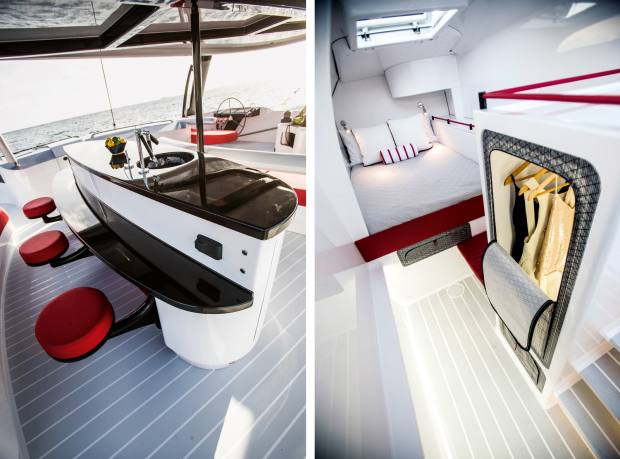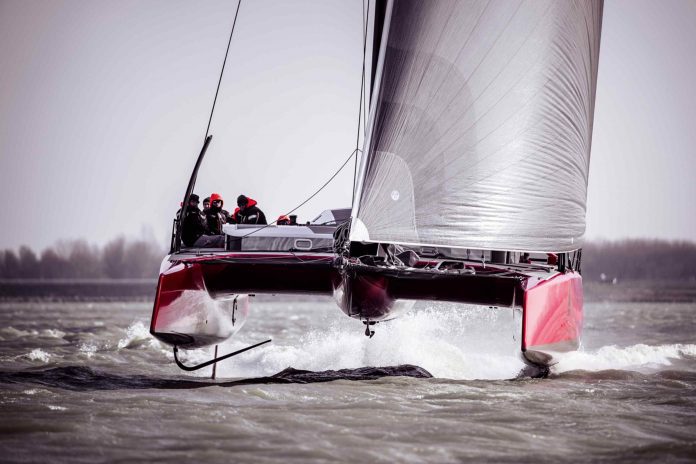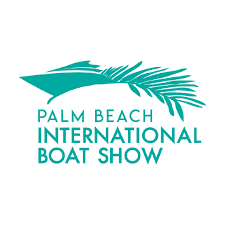Born of the 2013 America’s Cup, the wingmasted, foiling catamarans of the professional grand prix scene are spectacular to watch, but the higher they have ridden above the water’s surface and the faster they have gone, the further removed they’ve become from the mainstream sailing world. At least, that is the charge of those who have struggled to see the connection between these high-octane hydrofoiling machines – manned by Olympians and world champions – and everyday racers.

Yet the boats of the last two America’s Cup cycles did have an immediate impact on the dinghy and small-boat racing world, where new foiling designs aimed at ambitious, capable amateur-racing sailors flooded into the market. But it’s been hard to imagine how larger hydrofoiling craft, with the capability to race or cruise long distances offshore, could become more accessible to the mainstream.
However, the continual and rapid developments in some of the latest grand prix foiling machines, where computer-assisted flight is a key part of technical advances, could change that. In some cases, it has already and it is the most advanced end of the sport that is providing some of the answers.

The F50 class is the latest and most technically advanced foiling catamaran on the racing scene. Designed for SailGP, a new international racing circuit backed by IT billionaire and Oracle founder Larry Ellison, the new boats are updated takes on the 50ft foiling catamarans that competed in Bermuda for the America’s Cup in 2017. Redesigned, reconfigured and with the addition of some very sophisticated technical assistance, these new boats promise to take high-performance racing to another level with predicted top speeds in excess of 50 knots.

The smart technology in question is based on aircraft-style fly-by-wire technology in which computer software decides whether the manual human inputs are appropriate or, in some extreme cases, even safe. Many of us already use fly-by-wire technology in our everyday lives. For example, most modern cars have a similar system between the accelerator pedal and the throttle adjustment on the engine that allows its management system to decide how much power should be delivered depending on whether we have selected, say, sport or economy modes of driving. In short, what you do with your right foot is one thing; how the car decides to respond is sometimes rather different. Without this state-of-the-art intervention aboard high-performance boats like the F50, crews would struggle to handle the machines and it is this technology that is helping to take foiling beyond the inshore sprints of the America’s Cup and SailGP.

At the most extreme end are some of the world’s biggest offshore racers, the 32m-long and 23m-wide Ultime trimarans. These boats are starting to fly on hydrofoils as they race across oceans and embark on new around-the-world records. Some, like Macif, the recently launched Sodebo (both made by VPLP Design) and Gitana 17 (all about €10m-€12m), are even designed to be sailed single-handedly.

Meanwhile, at the less rarefied end of the sport the foiling revolution has seen new designs with bold ambitions aimed at a broader audience – among them the 12.74m-long DNA G4, a cruiser/racer catamaran (with a saloon, two queen-sized beds and an optional automated foil package for button-operated sailing), followed by the stripped-out racing F4 version (both from €1.1m). Both are designed to fly and both are aimed at owner/drivers.

Other designers and builders are taking a different route to the wider commercial world. Former America’s Cup team Artemis Racing regrouped after Bermuda as Artemis Technologies and is now working on commercial applications for foiling craft as well as a foiling superyacht for private ownership. To achieve these longer-term projects the company is developing a foiling powerboat (£3.5m) for the leisure market. “Work is already underway with our eFoiler, a 15m powerboat that has a range of 120 nautical miles, a cruising speed of 30 knots and a top speed of 50 knots,” says the company’s CEO, America’s Cup sailor and double Olympic gold medallist Iain Percy.

Not everyone who is considering the advantages of modern foils has set flying as the ultimate goal. Some are taking the lessons learnt with advanced hydrofoils to provide a faster and/or more comfortable ride without lifting the boat fully above the water’s surface. The Daedalus D80 ($12.5m), a semi-foiling luxury offshore cruising catamaran, uses a fly-by-wire system to lift the boat sufficiently in the water when at speed to reduce hull drag. Others, like USA-based builder Fast Forward Composites, are using the semi-foiling concept as a stepping stone towards creating a fully foiling cruising boat, with sleeping accommodation, that can be sailed by amateur crews. The first stage on the journey is the launch of the Eagle 53 catamaran ($7.95m). “Our client, saw the America’s Cup boats and said, ‘These boats can have practical applications for cruising. I want one and I want to be the first,’” says Tommy Gonzalez, professional skipper and president of Fast Forward Composites. “So that’s where we started with the entire Eagle project.”
The client, Donald Sussman, the American financier and philanthropist, wanted the ultimate weekender. A boat that would foil without a professional cup-winning crew and that would have 6ft 5in-tall cabins in each of the hulls, two full-length double beds, a full galley and many other cruising luxuries. But Gonzalez was clear that the route to this foil-borne cruising nirvana would take time. “We started by figuring out how we could create an efficient, complex, yet easy-to-control wing mast,” he says. “The result is a hybrid wing where around 50 per cent of the area is a solid wing mast and the remaining 50 per cent a soft sail that can be raised and lowered. “This rig is a little lighter than a conventional mast would be, but it is also a lot more efficient and much easier to handle. In 10 knots of breeze we can sail upwind at 15 to 18 knots easily and 22 knots off the wind and in flat water.” With the power plant in place, the next stage will be to add hydrofoils to get the boat flying. “Once testing is complete this season and the crew have got used to controlling the wing and feeling the boat, she will be fitted with electronically controlled T-foil hydrofoils that will allow the boat to rise above the water.”
The Eagle 53 will also have an automated safety-control system that takes over if the boat is travelling too fast or is heading towards an unstable situation. In essence, the flight controller will reduce the speed and lower the boat back down into the water. But the project extends beyond simply making a custom cruising catamaran fly. “We’ve built tooling so we can make seven of the 53s, but for us this boat is also a stepping stone towards a bigger project, an 80ft version,” Gonzalez continues. “Our plans at present are to build three of these bigger boats.”
Another key area of development in foiling technology has seen an increase in the stability of both racing and cruising boats. Dynamic Stability Systems (DSS), which pre-dates the move to foiling in the America’s Cup, has led the field with a technique that has been used in both performance and cruising applications. One of its recent projects, the new 43m superyacht by Baltic, is a good example of the comfort benefits that can be achieved. “Because DSS foils extend horizontally below the waterline, our system is more about providing greater stability than trying to make a boat fly,” says company co-founder Gordon Kay. “The key requirement for the Baltic project was to improve comfort by reducing the angle of heel by 10 degrees and also by reducing the pitching. At the same time, the system improves the performance aboard what is a luxurious cruising boat that has been designed to clock up 640km a day as it sails around the world. It’s an over-simplification perhaps, but the DSS system in this configuration is to boats what active suspension has been to cars. Making passengers more comfortable and less prone to feeling unwell is very important. It’s not always about speed.”
On a smaller scale Groupe Beneteau delivered the first production models of a 10.85m monohull, the Figaro 3 (€264,000), for the mass racing market last year. It too has foils, but instead of raising the boat clear of the water, these scythe-like devices stretch out from the hull’s topsides, acting like bicycle stabilisers. The curved foils that point downwards provide lift on the leeward side of the boat at a certain speed, which helps to reduce the amount that the boat slides sideways through the water. They also help to reduce heeling, which in turn increases the boat’s efficiency. “The move to foils for this third-generation Figaro boat was about reducing the heel without having to carry the heavy water ballast tanks that had been necessary on the previous model,” says product manager Luc Joessel. “At around 13-14 knots of boat speed you really start to feel the effect of the foils as they reduce heel and pitching.”
As yet Beneteau has no plans to roll this out to other models, but Joessel suggests it’s not difficult to see how such a system could benefit cruising sailors in the future.
While the sport is a long way from seeing amateur sailors handle F50 foiling cats, hydrofoiling is becoming a greater possibility for more sailors than was ever imagined just a few years ago. Add the potential benefits from the associated technology into the mix and it is easy to understand why so many at the leading edge in the sport are seeing the foiling movement as a true revolution that isn’t just about racing machines.





